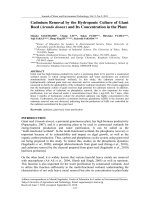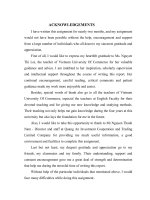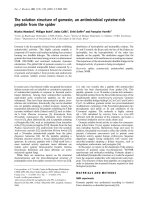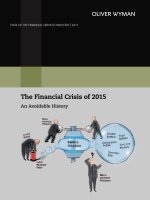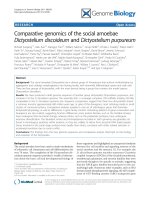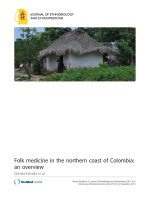The social profit of social an dlinguistic diversity and intercultural cooperation_LD
Bạn đang xem bản rút gọn của tài liệu. Xem và tải ngay bản đầy đủ của tài liệu tại đây (413.83 KB, 13 trang )
Council of Europe training Programme for
education professionals
Programme de formation du Conseil
de l'Europe pour les professionnels de
l'éducation
Training Resources:
Education for Linguistic
and Cultural Diversity
The social profit of social and linguistic
diversity and intercultural cooperation
in the classroom
Liutauras Degesys
Vilnius Pedagogical University,
Department of Social Sciences
E-mail address/:
Edited by Ildikó Lázár
June 2009
Theme: The social profit of social and linguistic diversity and
intercultural cooperation in the classroom
Title of unit: Tell me your story
General aims:
to help teachers benefit from cultural and social diversity in the classroom and school;
to stress the social profit of intercultural cooperation and collaboration;
to learn how to overcome cultural stereotypes;
to learn how to see things from different, often opposing, points of view.
Target audience:
Type of training
Initial and in-service training,
trainer training
School level
Secondary or tertiary
level
Subject area
Philosophy, languages,
methodology, pedagogy
Brief description of the unit:
This workshop principally intends to explore intercultural understanding and misunderstanding by means of
philosophical, critical and creative thinking and the technique called moral imagination. It is aimed to enrich
the inquiry focusing on improving relations between people of different cultural backgrounds and different
mentalities. This workshop is an application of a principle of intercultural dialogue. This application is based
on the idea of reciprocity as an attempt to see things from different, often opposing, points of view. It is based
on the belief that each person’s point of view becomes richer and more comprehensive when it is seen in the
context of many other points of view. The unit may be extended to include dialogues about similarities and
differences, and discussions about social profit of social and linguistic diversity in the class or community.
The aim should be to engage those who might see themselves as participants in a conflict of identities. In the
process of dialogue they should be asked not to accuse, justify or forgive, but just to tell their stories and
analyze them, noticing the reasons behind the different perspectives of different identities.
Methods/techniques used:
Individual work, pair work, whole class discussion based on stories, work of art and moral imagination
Time:
Whole unit: 8 academic hours = 360 minutes
Activity 1:
Activity 2:
Activity 3:
Activity 4:
90 minutes
90 minutes
90 minutes
90 minutes
Resources:
Pictures of works of art and/or passages from novels, newspapers
The schemes and tables in the Annexes
Tips to trainers:
Be ready to reflect on and discuss various situations as well as to make quick on-the-spot decisions
with all the moral responsibility that these decisions require.
Doing the four activities in a sequence may become monotonous so you may want to use them
integrated with other activities during the course.
Too large groups may interfere with the aims and destroy the dialogical nature of the activity because
it is impossible for all the participants to articulate their views and justify them.
90 minutes
Activity 1
Title:
Look at a work of art and tell me your story
Specific aims:
Teachers will challenge stereotypical images of other places and cultures.
Teachers will develop skills that will help students to combat prejudice and discrimination.
Resources:
The scheme for telling stories: Action, Intention, Outcome (See Annex 1).
A text or a photo of any work of art: a painting, a passage from a novel, a scene from a movie or an
article from a newspaper
Practical arrangements:
Seating must be appropriate for pair work and whole class discussion
Instructions:
Introduction
It has to be stressed that this training programme is principally aimed for the exploration of intercultural
understanding and misunderstanding by means of philosophical, critical and creative thinking. Young people
should be given the opportunities to understand the global context of their local lives, to appreciate the
similarities between peoples everywhere, so they must be enabled to develop skills that will help them to
combat prejudice and discrimination. The school curriculum should contribute to the development of pupils’
sense of identity through knowledge and understanding of the spiritual, moral, social and cultural heritages of
diverse societies and acquiring the knowledge, skills and understanding necessary for the interpretation of
the local, national, European, commonwealth and global dimensions of their lives. The learning must enable
people to respond positively to the opportunities and challenges of the rapidly changing world, and it should
reflect the enduring values that contribute to social justice, respecting differences and human rights. An
important aspect of learning is to challenge stereotypical images of other places and cultures. This session
aims to portray a more balanced view, seeing the positive as well as the negative and highlighting similarities
as well as differences of historical and social contexts of different cultures.
Procedure:
1. Ask the group to form pairs but tell them that they will be working individually first.
2. Give a copy of the same work of art to each participant. Ask them to reflect on the painting, the
fragment of a novel, the movie scene or the newspaper article you selected for them. Ask them to be
prepared to tell the story about the painting, movie, newspaper or novel, interpreting the same
situation, emphasizing rightness or wrongness of action, intention and outcome.
3. Working individually, they should prepare to tell a story about this painting (ANTONELLO da
Messina, St. Sebastian in the example here), interpreting the situation, emphasizing rightness or
wrongness of action, intention or outcome. They should think about or write down what the story is:
What happened, who was responsible for what (right or wrong) action, what were their intentions
(positive, negative), and what kind of outcomes they discover. Are they positive or negative?
4. Pair work: Exchange stories with your partner and re-tell the same story from different cultural, social
or linguistic perspectives, changing the interpretation of rightness or wrongness of action, intention or
outcome.
5. Whole class: You may want to ask the whole group to read out their stories. Then present the
scheme (see Annex 1) and discuss the different interpretations made on different cultural - social
backgrounds (prejudices, education, traditions, religion, politics etc.). Stress the idea of intercultural
dialogue extended to the dialogue about differences. Two aspects of “similarities” and “differences”
should be regarded not as alternatives, but as aspects of the same process of cultural diversity and
dialogue. During the debriefing discussion stress the social profit of intercultural cooperation and
collaboration using some of the questions suggested below.
Debriefing/reflecting:
It may be useful to discuss the points and questions below when debriefing the activity:
1. Any action may be treated as right or wrong - depending on the interpretation which, in
turn, depends on the speaker’s cultural and social background (prejudices, education,
traditions, religion, politics, etc.).
2. Any intention may be treated as right or wrong - depending on the interpretation which, in
turn, depends on the speaker’s cultural and social background (prejudices, education,
traditions, religion, politics, etc.).
3. Any outcome may be treated as right or wrong - depending on the interpretation which, in
turn, depends on the speaker’s cultural - social background (prejudices, education,
traditions, religion, politics, etc.).
4. All these interpretations may lead us to an intercultural dialogue. Intercultural dialogues
must be encouraged and fostered.
5. An intercultural dialogue should not be limited to the dialogue about convergence, but
should be extended to the dialogue about differences. Two things that seem similar in one
culture may be seen as different in another culture. We may interpret the very same things
as similar or different depending on our perspective.
6. The intercultural society model is based on the principle of equality between cultures.
Efforts should be made to look for multiple ways of expressing diversity. Cultural diversity
should be regarded as synonymous to exchange, should be promoted to increase
awareness of the richness of that diversity, and should stress the social profit of intercultural
cooperation and collaboration.
7. These situations should be explored in order to start a dialogue and to identify solutions
that enable intercultural conflicts to be prevented and cultural diversity to be promoted.
What did you learn from this activity? What would your students learn from an activity like this?
Does the interpretation of a work of art give us the chance to practice looking at things from
different, often opposing, points of view? If yes, how? If no, why not?
Do interpretations of and discussions about a work of art provide opportunities for students to
learn how to overcome cultural stereotypes? If yes, how? If no, why not?
Antonello da Messina, St Sebastian
Tips to trainers:
Art in the school curriculum may give a sense of identity through knowledge and understanding of
the spiritual, moral, social and cultural heritages of your own and diverse other societies.
Discussing art may develop skills that will help teachers and students to combat prejudice and
discrimination.
90 minutes
Activity 2
Title:
Become an ‘I’ and let others be ‘I-s’ – Logic to help avoid intercultural misunderstanding
Specific aims:
Teachers will collect examples of “good practice” based on different interpretations from different
cultural mentalities.
Teachers will learn how to overcome cultural stereotypes and foster intercultural cooperation in the
classroom.
Teachers will learn how to develop skills that will help students to see their personal point in the
context of many points of view.
Resources:
The scheme of telling stories: Action, Intention, Outcome (See Annex 1).
The logical scheme of making decisions
Practical arrangements:
Seating must be appropriate for pair work and whole class discussion
Methods/techniques:
individual work, whole class discussion
Procedure:
1. Give the same social/moral/political/religious situation to all members of the training session, for
example:
1. The dilemma of the taxi driver
A taxi driver finds a suitcase full of money in his car. His father is ill and he has got no resources to
save him. Should he return the money? Should he keep the money in the hope to save his father’s
life?
or use the example on
2. The Prohibition of the Exposure of Religious Symbols in Public Functions (See detailed
description in Annex 5).
2. Participants are asked to be prepared to give different interpretations of the same situation, emphasizing
rightness or wrongness of action, intention or outcome. There are eight possible different logical
interpretations based on different cultural, social, linguistic backgrounds and emphasizing possible
moral, social and cultural prejudices and stereotypes, concerning our attitudes to money and life/death
(example 1) or the prohibition of the exposure of religious symbols in public functions (example 2).
3. Ask the participants to be prepared to give at least three different interpretations based on different
cultural, social, linguistic backgrounds, i.e. the same situation in different cultural interpretations may
seem as:
a) Right action, based on positive intention leading to a positive outcome;
In another cultural context the same situation may be interpreted as:
b) Right action, based on negative intention leading to a positive outcome;
In a third cultural context the same situation may be interpreted as:
c) Wrong action, based on negative intention leading to a positive outcome
Instructions:
1. Tell the story interpreting the situation from different socio-cultural backgrounds, emphasizing rightness
or wrongness of action, intention or outcome.
2. Tell the story interpreting the situation from different linguistic backgrounds, emphasizing rightness or
wrongness of action, intention or outcome.
Tips to trainers:
For extensive explanations and examples, see Annex 5.
Make sure to point out that each person’s point of view becomes richer and more comprehensive
when it is seen in the context of a variety of points of view.
Philosophical, critical and creative thinking and the method called moral imagination may improve
the relations between people of different cultural backgrounds and different mentalities.
Debriefing/reflecting:
How do you think the different interpretations based on different cultural, social, and linguistic
backgrounds may help to overcome cultural stereotypes in your classes?
Do you think philosophical, critical and creative thinking and the method called moral imagination
can help to improve relations between students of different cultural backgrounds and different
mentalities in your classrooms? In what ways?
45-90 minutes
Activity 3
Title: Historical and everyday life heroism – Femininity and cultural and social misunderstandings
Specific aims:
to learn how to see things from different, often opposing, points of view;
to learn how to overcome social, cultural and gender-related stereotypes;
to learn how to develop skills that will help students to see their personal point of view in the context
of many points of view.
Practical arrangements:
You need to have a sufficient number of copies of the table in Annex 2.
Methods/techniques:
Participants will work individually, in pairs and then as a whole class.
Procedure:
1. Ask participants to discuss and reach a common understanding of what heroism means to them.
2. Give copies of the same table (see table 1 in Annex 2) to participants. Ask them to fill in the table,
reflect on their answers and be prepared for the interpretation of the same situations according to
what they wrote in the table.
3. Participants exchange tables with their partners and think of different interpretations of the same
situations from different cultural or social perspectives.
4. Pairs reflect on and explain to each other the different interpretations of the situations, described in
the table, emphasizing possible moral, social and cultural prejudices and stereotypes, concerning
the idea of historical and everyday life heroism. They should also be encouraged to think of possible
cultural misunderstandings resulting from the differences in interpretations.
5. Whole class: Discuss the various interpretations made on different cultural - social backgrounds
(prejudices, education, traditions, religion, politics, etc.). Remember that two aspects of “similarities”
and “differences” should be regarded not as alternatives, but as aspects of the same process of
cultural diversity and dialogue. Do not confront these aspects, but use them as logical possibilities…
Debriefing/reflecting:
How does the interpretation of a variety of situations give us a chance to start looking at heroism
from different, often opposing, points of view?
How does this activity help overcome cultural stereotypes?
45-90 minutes
Activity 4
Title: Heroes and Heroines – Femininity and cultural and social misunderstandings
Specific aims:
to learn how to see things from different, often opposing, points of view.
to learn how to overcome social, cultural and gender-related stereotypes;
to learn how to develop skills that will help students to see their personal point of view in the context
of many points of view.
Practical arrangements:
You need to have a sufficient number of copies of the table in Annex 2.
Methods/techniques:
Participants will work individually first, and then as a whole class.
Procedure:
1. Give the same social/moral/political/religious situation described in the table to all members of the
workshop (see table 2 in Annex 3). Ask them to prepare individually to give different interpretations of
the same situation, emphasizing different cultural, social, linguistic backgrounds. In other words, the
same situation in different cultural interpretations may seem as women’s heroism or men’s heroism.
2. Look at the interpretations and reflect on the possible cultural and social stereotypes, prejudices or
even forms of sexual discrimination.
Debriefing/reflecting:
How do the different interpretations based on different cultural, social, linguistic backgrounds
may help to reveal, detect or even overcome cultural stereotypes prejudices or even forms of
sexual discrimination?
How does the philosophical, critical and creative thinking invested in a task like this one may
help to solve the problem of improving relations between people of different cultural backgrounds
and different mentalities?
Bibliography:
Council of Europe. (2000, December 7). Declaration on Cultural Diversity.
Degesys, L. & Askinyte-Degesiene, R. (2003). Ethics as a Theory and Practice of Logical Thinking. Vilnius,
Pedagogical University Press /In Lithuanian/.
Gregory M. (1999). A Crash Course in Logic. New York:
.
Lipman, M. & Sharp, A. M. (1994). Growing up with Philosophy. Institute for the Advancement of Philosophy
for Children, Montclair, Montclair State University Press.
Lipman, M. (1988). Philosophy Goes to School. Temple University Press.
Lipman, M. (1991). Thinking in Education. Cambridge University Press.
Universal Declaration of Human Rights. Article 18 />
Annex 1
Scheme 1
Telling Stories in Intercultural Dialogue
Right
Action
Intention
↓
↓
Positive
(Good)
Negative
(Evil)
↓
Result
(Outcome)
Wrong
↓
Positive Negative
good
bad
↓
↓
Positive
(Good)
↓
Positive Negative
good
↓
bad
↓
Negative
(Evil)
↓
Positive Negative
good
bad
↓ ↓
Positive Negative
good
bad
Tell the story anticipating eight versions of possible actions, intentions and various outcomes. Collect
examples of “good practice” based on different interpretations from different cultural mentalities.
1.
2.
3.
4.
5.
6.
7.
8.
Right action, based on positive intention leads to the positive outcome.
Right action, based on positive intention leads to the negative outcome.
Right action, based on negative intention leads to the positive outcome.
Right action, based on negative intention leads to the positive outcome.
Wrong action, based on positive intention leads to the positive outcome.
Wrong action, based on positive intention leads to the negative outcome.
Wrong action, based on negative intention leads to the positive outcome.
Wrong action, based on negative intention leads to the negative outcome.
Annex 2
TABLE 1
Action, state
Historical and everyday life heroism
It is heroism, no
matter of
dispute
It is heroism but
as a matter of
discussion
It is not heroism,
but as a matter
of dispute
It is not heroism,
no matter of
dispute
1. Love
2. Rescuing a drunkard
3. Fighting the enemies
4. Fighting disease
5. Refraining from...
6. Life long learning
7. Pursuit of happiness
8. Helpfulness
Annex 3
TABLE 2
Action, state
1. Self-possession
2. Responsibility
3. Driving
4. Love
5. Rescuing a drunkard
6. Fighting against the enemies
7. Fighting disease
8. Refraining from...
9. Life long learning
10. Pursuit of happiness
11. Helpfulness
Heroes and Heroines
It is men’s heroism, no
matter of dispute
It is women’s heroism
no matter of dispute
It is human heroism
but as a matter of
discussion
Annex 4
Theoretical background
This unit is principally aimed for the exploration of intercultural understanding and misunderstanding by
the means of philosophical, critical and creative thinking and the method called moral imagination. It is
aimed to add to the inquiry about improving relations between people of different cultural backgrounds
and different mentalities.
This unit consists of four activities and is itself an application of a principle of the intercultural dialogue.
This application is based on the idea of reciprocity as an attempt to see tthings from different, often
opposing, points of view. It is based on the idea that each person’s point of view becomes richer and
more comprehensive when it is seen in the context of many other points of view. It is a dialogue about
similarities and differences and what separates cultures and populations. The aim should be to engage
those who might see themselves as participants in a conflict of identities. In the process of this
dialogue they should be asked not to accuse, justify or forgive, but just to tell their stories and analyze
them, seeing the reasons behind different perspectives of different identities.
Intercultural dialogue – it is fostering all forms of cultural diversity in all dimensions: social, political,
economic, philosophical, religious, moral or aesthetic.
Cultural diversity – “Cultural diversity is expressed in the co-existence and exchange of culturally
different practices and in the provision and consumption of culturally different services and products” –
this definition comes from the Council of Europe Declaration on Cultural Diversity, 2000, December 7.
Cultural diversity brings enrichment to individuals and groups, fosters new forms of social relationships,
raised on the processes of migration and strengthened by processes of exchange, and creates new
forms of multicultural identities. Cultural diversity must not lead to ethnocentrism or domination, as both
may lead to conflicts. Cultural diversity may strengthen peace through knowledge, acceptance and
recognition in the development of all cultures from different geographical areas inside or outide Europe.
Conflict of cultures – form of disagreement, based on a failure to accept cultural diversity and
democratic openness. Conflicts of cultures may lead to injustice or even to violent and destructive
behaviour. Conflicts arise for complex reasons – not only for cultural – for political, economic and social
reasons. The problem is how to detect and control cultural conflicts within European societies
characterised by cultural diversity.
Identity is awareness of ourselves: it is the awareness of belonging to some community, to some
relationships, to some space and time. To be honest, identity is awareness not only of ourselves but
also awareness of Others. We come to know ourselves as persons by sharing experiences, ideas and
feelings with other persons. It is clear that our identity is bound up with our interdependence. Different
identities are entities of faith, historical memory, moral imagination and human interrelationship. The
idea of identity supposes the idea of dialogue among civilizations and the idea of complementarities of
different cultures. The dialogue among different cultures is unthinkable without the permanent interplay
and inter-exchange of human thought and creativity in science, art and philosophy and dialogue is the
only means to build a world of human dignity, solidarity and hope. This principle cannot be applied in
terms of “majority” and “minority”.
What is common in the very classical concept of European identity is that it is based on the idea of such
thinking and ethical strategies as empathy, decentering from the self and moral imagination. Let
us clarify some basic concepts in connection with the European identity. It is called the Western tradition
of thinking, but let us discuss how these things are common for all Europe.
One of ethical strategies in the very classical concept of European identity is called strategy for
decentering from the self: it is based on the idea of reciprocity as an attempt to see things from
different, often opposing, points of view. First of all, it means that the self becomes an ‘I’ if it lets other
selves be ‘I-s’. Then the person may expect the same recognition from the other ‘I’ towards his or her ‘I’.
Secondly, it means that each person’s point of view becomes richer and more comprehensive when it is
seen in the context of many other points of view.
Let us see in the exercises what may happen if we keep going along this line of thinking. It is a
challenge to think about possible interpretations of actions, intentions and outcomes from a variety of
perspectives.
All these interpretations may lead us to an intercultural dialogue and the intercultural dialogue must be
encouraged and fostered. This principle is based on the principles of freedom of thought, of conscience,
of religion, of expression, of assembly and of association – defined in the Convention for the Protection
of Human Rights and Fundamental Freedoms. The intercultural dialogue should not be limited to the
dialogue about convergence, but should be extended to the dialogue about differences. Two things that
seem similar in one culture may be seen as different in another culture. We may interpret the very same
things as similar or different depending on our perspective.
The intercultural society model is based on the principle of equality between cultures. Differences and
distinctions should not be viewed as obstructions or obstacles and should not be viewed in terms of
“majority” and “minority”, trying to overcome cultural stereotypes and practice of “right” types of social
behaviour. Efforts should be made to look for multiple ways of expressing diversity. Cultural diversity
should be regarded as synonymous to exchange, should be promoted to increase awareness of the
richness of that diversity, and should stress the social profit of intercultural cooperation and
collaboration. These situations should be explored in order to start a dialogue and to identify solutions
that enable us to prevent intercultural conflicts and to promote cultural diversity.
Annex 5
TELLING STORIES IN INTERCULTURAL DIALOGUE
On the Prohibition of the Exposure of Religious Symbols in Public Functions
“We hold these truths to be self-evident, that all men are created equal, that they are endowed by their
Creator with certain unalienable Rights, and that among these are Life, Liberty and the pursuit of
Happiness. That to secure these rights, Governments are instituted among Men, deriving just their
powers from the consent of the governed”.
American Declaration of Independence (1776) />Examples:
The action denying the prohibition of the exposure of religious symbols in a public function may be
interpreted as right and may be based on different intentions. On the one hand, it can be based on a
positive (good) intention. On the other hand, it can also be based on a negative (evil) intention. In the
interpretation of this story in an intercultural dialogue it is possible to explain the positive intention of
denying the prohibition of exposure of religious symbols in a public function by referring to the freedom of
religion. The negative (evil) intention in the other interpretation of this right action will be the indifference
towards the other and a relativistic attitude towards different opinions and beliefs. These two different
intentions may then, on their turn, lead to four different results or outcomes.
The positive intention of this interpretation of the Prohibition of the Exposure of Religious Symbols in
Public Functions is based on the principle of freedom of religion. It is the freedom of an individual or
community, in public or private life to manifest religion or belief in teaching, practice, worship, and
observance. It is generally recognized to include the freedom to change religion or not to follow any
religion. Freedom of religion is considered by many nations and people to be a fundamental human right
and it is recognized as such in the Universal Declaration of Human Rights.1
The positive (good) intention may lead to two different results namely a positive and a negative outcome.
The positive result may be diversity and pluralism. As a result of the freedom of religion, different
convictions and a variety of different lifestyles are recognized. The action denying the prohibition of the
exposure of religious symbols in a public function that is based on the positive intention of freedom of
religion leads to the diversity of society that is signed and colored by different cultures and religions. It
leads to an open-minded view towards cultural diversity and the world that we live in. On the other hand,
it is also possible that the action denying the prohibition of exposing the religious symbols in the job of
civil servants, based on the positive intention of ensuring freedom of religion, leads to the negative result
of developing prejudices against those people who express their religion during their working hours. It
may also lead to the strengthening of conservative thoughts in a multicultural society. It can lead to
thoughts of ‘us’ against the ‘others’. Unfortunately, it can lead to partiality and discrimination towards
people when they apply for the job of civil servant…
The prohibition of religious symbols in public functions may be interpreted as “wrong” action. Again it is
possible to elaborate four different stories based on four different interpretations. The positive intention of
the prohibition of the exposure of religious symbols in public functions may rely on the argument that the
neutrality of the state has to be ensured and the separation of Church and State has to be guaranteed.
The negative intention of the “wrong” action will be discrimination and intolerance towards the other.
These two intentions will lead again to four different results.
The prohibition of the exposure of religious symbols in the jobs of civil servants, based on the need to
separate Church and State and based on the guarantee of the neutrality of the state, can lead to the
positive result that there is no longer partiality in public functions, and that no one will give rise to partiality
when someone is confronted with a civil servant. It leads to the outcome that the representatives of the
state and the state itself should act like a neutral institution towards different opinions, religions, beliefs or
convictions of the people. The prohibition of the exposure of religious symbols in public functions, based
on this positive intention, also tries to lead to the promotion and respect for cultural diversity and
pluralism despite the fact that the action is completely different. On the other hand, the action of the
socio-cultural situation of the interference between the state an religion, based on the need to separate
Church and State and the neutrality of the state, can also lead to a negative result if the state doesn’t
support any longer the development of personal identity and the right to freedom of religion in public and
1
Cfr. article 18 of the Universal Declaration of Human Rights. />
private life. In this case the state doesn’t support the values of the liberal point of view anymore, it doesn’t
cherish freedom anymore. Neither does it try to fight and get rid of oppression, discrimination and
petrifaction. In this case it attacks the liberal state.
Let’s take a look at the results that surfaced, telling two more stories by transforming the positive
intention to guarantee the neutrality of the state and the separation of Church and State into the negative
intention of discrimination and intolerance towards others who have different beliefs and convictions.
The positive result that will arise if there is a prohibition of the exposure of religious symbols in public life,
based on the negative intention of discrimination and intolerance towards different religious lifestyles is
that there will probably be no prejudices anymore against civil servants of different religions simply
because of the fact that nobody will know it anymore to which religion someone belongs. In this case it
would lead to the positive outcome that everybody would be treated as equal, without partiality based on
religious beliefs towards one or another. There is no doubt that this would also be a positive result
although it would derive from a “wrong” action that it is based on a “negative or evil” intention. On the
other hand, if there is a prohibition of expressing religious symbols in the job of civil servants, based on
the negative intention of discrimination and intolerance against different religions, then the problem of
increased aversion and repression against someone’s beliefs and convictions will probably arise as a
negative outcome.
